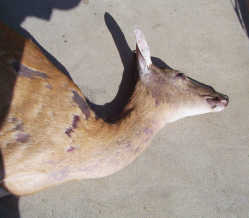Deer death toll nears 100

Putnam County residents have now reported 98 different dead deer, fallen from what is believed to be an Epizootic Hemorrhagic Disease (EHD) epidemic.
Department of Natural Resources District Wildlife Biologist Dean Zimmerman said he has been contacted by 33 Putnam County residents, most from the southern half of the county.
There has also been one reported case near Bainbridge.
The deer population in Putnam County is unknown, but the death toll is significant.
"To put the 98 deer reported dead this year in perspective," Zimmerman said, "in 2006 we had a significant outbreak of EHD with 300 deer reported dead, but that was over five or so counties."
He also noted that there were 108 deer/vehicle accidents reported in Putnam County in 2011.
When the Banner Graphic first reported the outbreak on Aug. 1, there were about 20 reported cases, mostly in the Putnamville area.
Though 98 have been reported, Zimmerman estimates that the actual number may be more like 300.
Following the last outbreak in 2006, hunting totals dropped 23 percent from the previous year (922 antlered bucks were harvested in 2005 fell to 707 in 2006). The deer population returned relatively quickly with 926 bucks being harvested in 2009.
The problem is not exclusive to Putnam County, but there does seem to be a large concentration here.
"A total of 17 counties statewide have reported deer losses where we suspect EHD," Zimmerman said. "Only two or three reports have come in neighboring Parke County, and similarly in Clay and Owen counties."
EHD, commonly and incorrectly referred to as bluetongue, is a viral disease spread by biting midge, small insects that frequent streams and ponds where deer go to drink.
Outbreaks generally occur later in the year, but the dry summer has increased the size of midge habitats and allowed the epidemic to occur much earlier.
"They (midge) reproduce more successfully in dry weather, which is why EHD is more of a problem this year in some areas," Zimmerman said. "We can only wait for the killing frost later this fall to kill the midges and end the outbreak."
Humans are not at risk for the disease, though it is recommended that people don't eat decaying animals they find near water.
Zimmerman is requesting that anyone who finds a dead deer in or near water contact him at (765) 567-2152.
EHD has been confirmed in four Indiana counties, including Morgan.
Though Putnam County cases have not been confirmed, EHD is strongly suspected to be the cause.
A test must be done within 6-10 hours of death for a confirmation, though no further tests are planned for this time.
